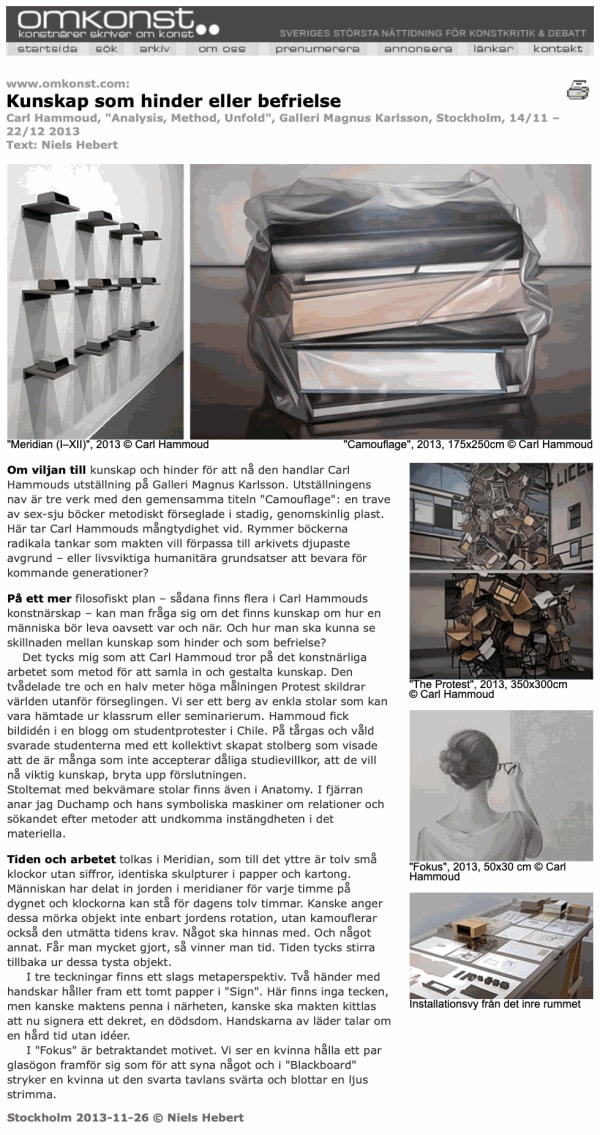Carl Hammoud | Analysis, Method, Unfold
We are pleased to announce Carl Hammoud’s fourth solo exhibition at the gallery: Analysis, Method, Unfold. The exhibition consists of new paintings, drawings and sculptures accompanied by a room displaying a selection of sketches, notes and other references used in conjunction with the works. The exhibition title refers to the structure of learning as well as the artistic practice.
In recent years Carl Hammoud has gradually turned his focus toward the process itself, to a point where the works seem to deal with their own conception. By examining and analyzing his practice, Hammoud creates a world reflecting the reality outside the four walls of the studio. In this manner, he has approached his own history and the choices he has made, to convey something that concerns us all.
Accompanying the exhibition is a small notebook (available only in Swedish) with the artist’s ideas and thoughts on his work.
The artist’s intention, or the idea that induces the artwork, is subordinate to the unforeseen contingencies that may arise in the movement towards the goal. Incidents that can change the process and thus the final result.
The symbolic and historical qualities of the materials along with coincidence, or the inability to control the chemical and physical processes, create a kind of chaos factor: an abstract complexity.
It is the abstract complexity that separates the artwork from the spoken and written language, a complexity whose components forms an equation without a given solution. Something that simply makes it impossible to describe the actual magnitude of an artwork.
As a symbol of knowledge, the book has been a recurring motif in Carl Hammoud’s imagery. In the painting Camouflage a stack of books are wrapped in plastic that functions both as protection and a barrier. A thin membrane that stands between accessibility and inaccessibility. A similar approach is found in The Protest, where a mountain of school chairs is transformed into a monument of impossible learning. The original photo was taken during the student protests in Chile 2011–2012 and the work corresponds both with Doris Salcedo’s installations and Ai Wei Wei’s Bang at this year’s Venice Biennale. Alongside the paintings and drawings, Carl Hammoud also works with sculptures made of paper and cardboard. Meridian consists of twelve flip clocks that are installed as a group on one of the gallery walls. The individual clocks remind us of the separate events that constitute our collective memory, and as a whole they describe the extended moment that characterizes a work of art.
Carl Hammoud (b.1976) lives and works in Stockholm, Sweden. He has exhibited in galleries and museums in Europe, Asia and USA. Selected Solo Exhibitions: Lora Reynolds Gallery, Austin, Texas, USA (2013), Baton Gallery, Seoul, South Korea, two-person-show together with Jens Fänge (2012), Frieze Art Fair, London (2011), Kalmar Konstmuseum (2011), Malmö Art Museum (2010), Gothenburg Museum of Art (2010), Galleri Magnus Karlsson, Stockholm (2009, 2007, 2005), Bellwether Gallery, New York, USA (2007). He has participated in group exhibitions at Magasin 3 Stockholm Konsthall (2010), Eskilstuna Konstmuseum (2010), Borås Museum of Arts (2009) and Göteborgs Konsthall (2008). In 2012 he received Åke Andrén Foundation Art Scholarship. He is represented in the collections of Moderna Museet, Stockholm, Magasin 3 Stockholm Konsthall, Gothenburg Museum of Art and the British Museum, London.














